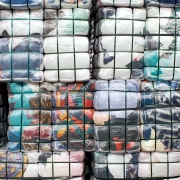Textiles Division: “Inflection point” Has Been Reached in Drive for Textiles Circularity
While further innovation and investment were required to build a more circular textiles economy, substantial progress had been made in recent years as a result of the growing momentum behind sustainability, it was agreed by a panel of experts at the BIR Textiles Division meeting in Barcelona on May 24.
Unlike only a handful of years ago, “many brands are coming to us and asking how they can get access to recycled yarn,” reported Maud Hardy, General Manager of French producer responsibility organization Refashion which is co-ordinating the country’s EPR scheme for clothing, household linen and footwear. Session moderator Alan Wheeler of the UK’s Textile Recycling Association added that retailers were now keen to know where to source recycled products – “a definite shift from where we were just a few years ago”.
“The good news is that there is demand out there and it’s coming not just from our customers but effectively from consumers as a whole,” stated Erik Koep, CEO of UK-based Worn Again Technologies. His business develops polymer recycling processes for non-reusable textiles which entail separating, decontaminating and extracting polyester and cellulose (from cotton) to produce dual PET and cellulose outputs. The company was aiming to build an average of two or more plants per year, he told delegates.
In response to an observation from Mr Wheeler that investment from the textiles industry had been somewhat limited to date, Mr Koep suggested that the technology had not been available in the past to capitalize on the demand for sustainability but that this was now starting to come on line. “And so, very rapidly, I think we are going to see the investment right behind it,” he contended. “I do believe we are at that inflection point.” According to Ms Hardy, progress in France had included a new anti-waste law calling for even higher collection targets and an environmental impact grading system to promote better product design.
However, all participants agreed that work remained to be done to achieve textiles circularity. Mr Wheeler called for “ambitious” targets from the fashion industry regarding its recycled content incorporation rates. And the BIR Textiles Division’s President, Martin Böschen of Switzerland-based TEXAID – Textilverwertungs AG, highlighted the need for “more automation in the sorting process” that would deliver an accurate assessment of material composition. Recycling processes needed to be “somewhat flexible”, he added. “The ones which are really narrow on the input side will not fly because we will not be able to supply material to 100% purity”.
Mr. Böschen also contended that the proposed revision of the EU’s Waste Shipment Regulation could seriously impact exports of unsorted clothing, and so more sorting capacity would be required within Europe. He also emphasized that the aim of legislators and others should be to keep products in use for as long as possible because even recycling had an environmental impact.
In his final question to the expert panel, Mr Wheeler asked for a brief comment on what success would look like in 2030: Mr. Böschen’s response was “a large percentage of recycled content in new textiles” and Mr Koep’s “a healthy circular marketplace”, whereas Ms. Hardy said success would be the disappearance of her organization Refashion – simply because it would mean that its task had been fulfilled and that “circularity is real and working”.
Source: BIR (Brussels, 31 May, 2022)





